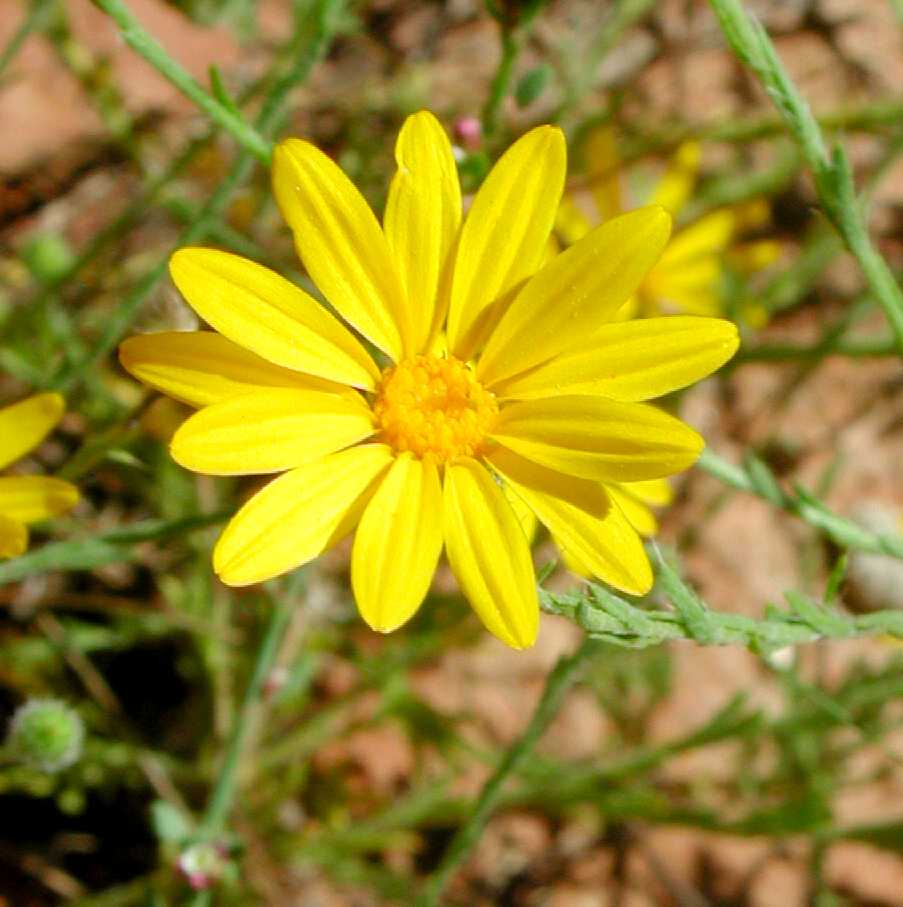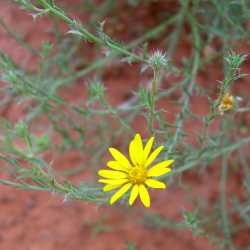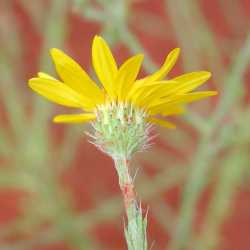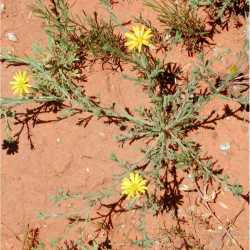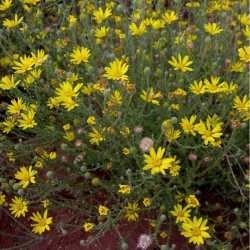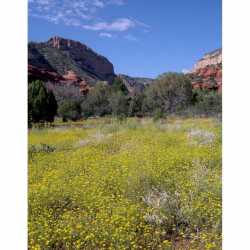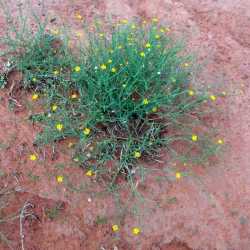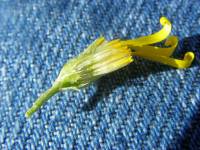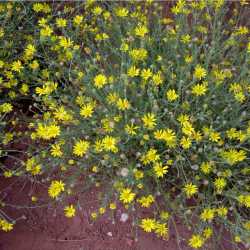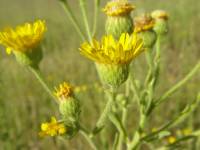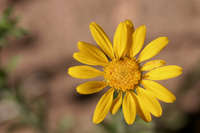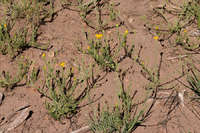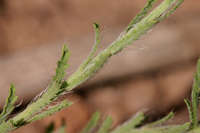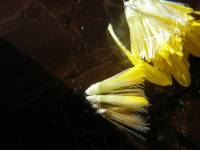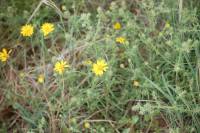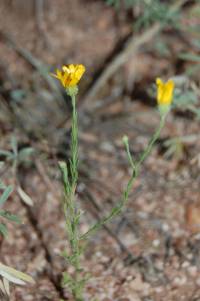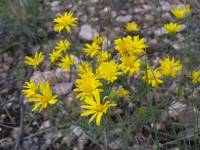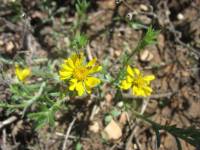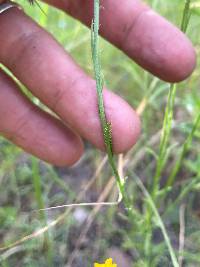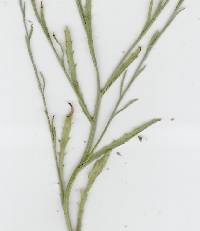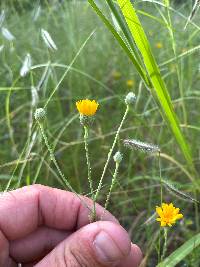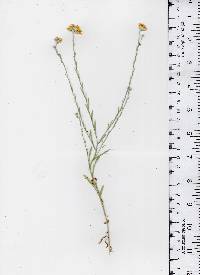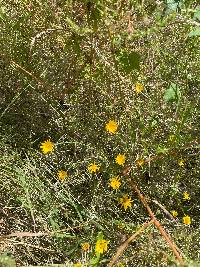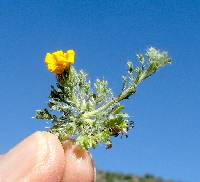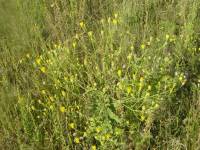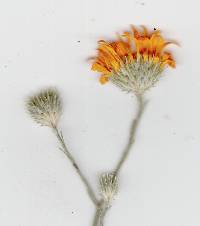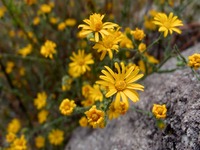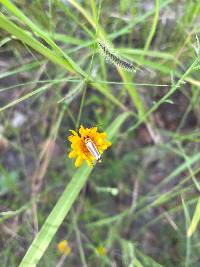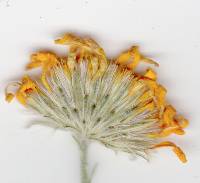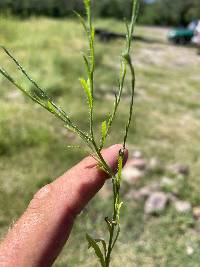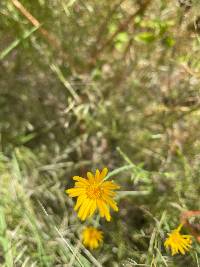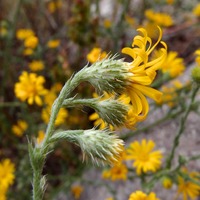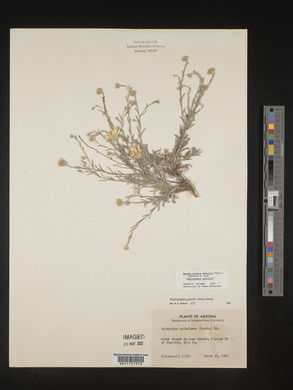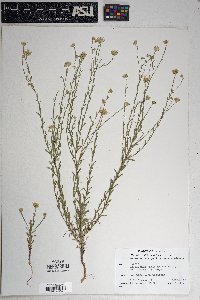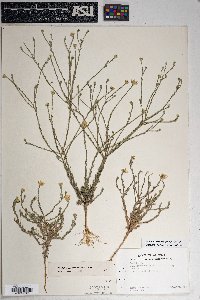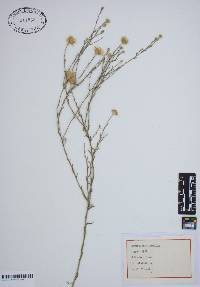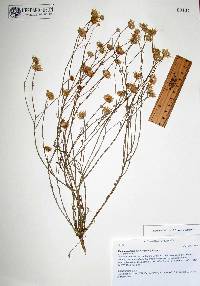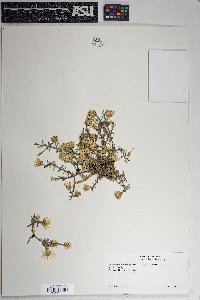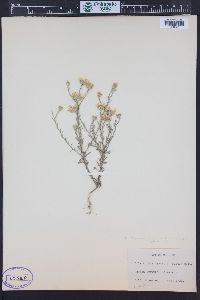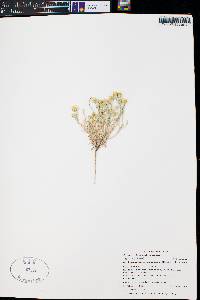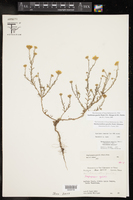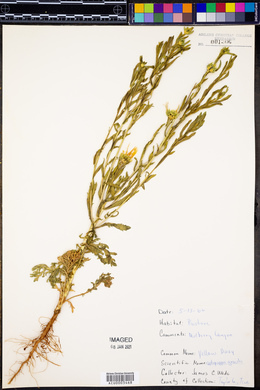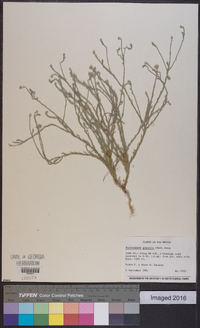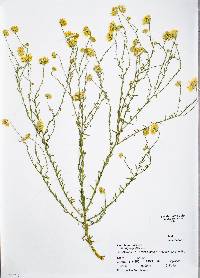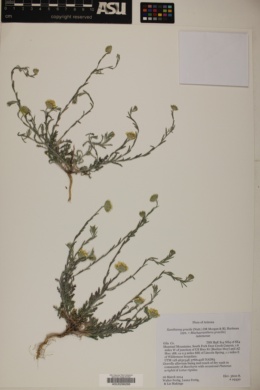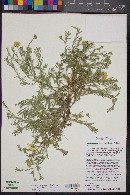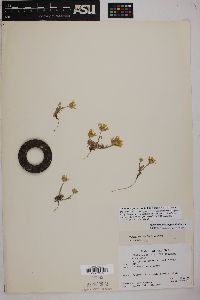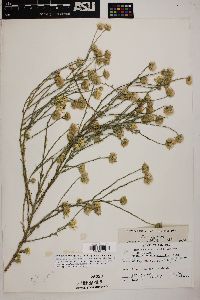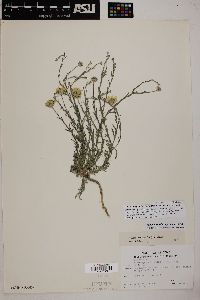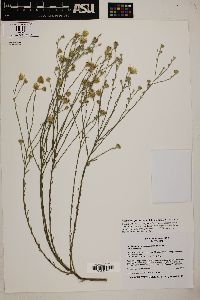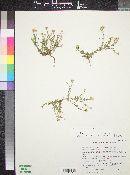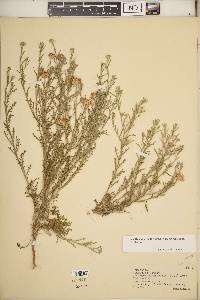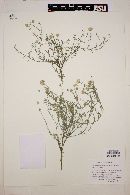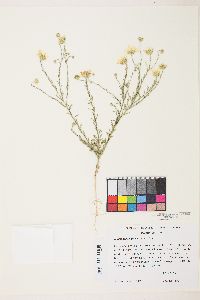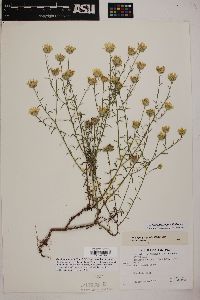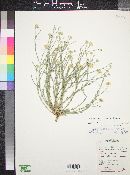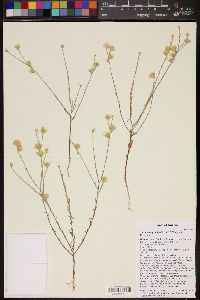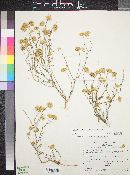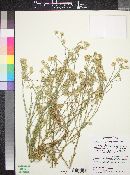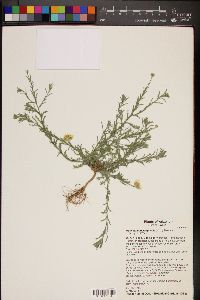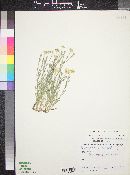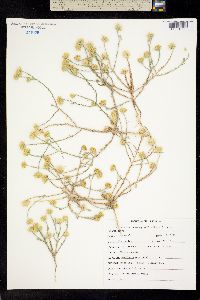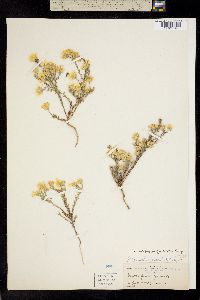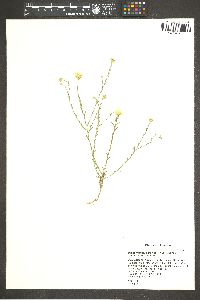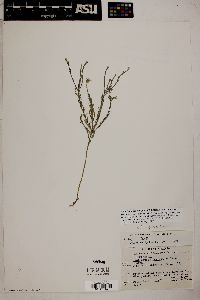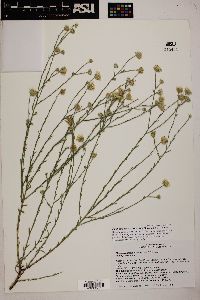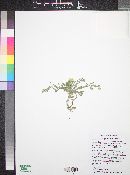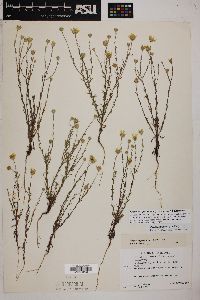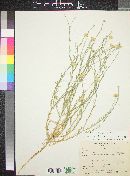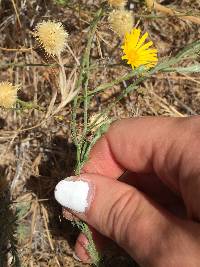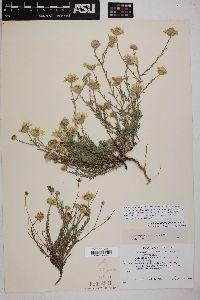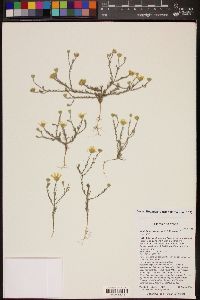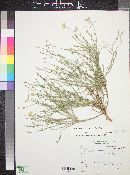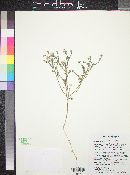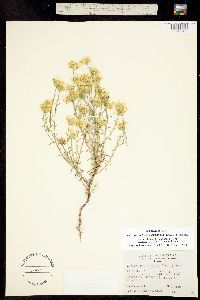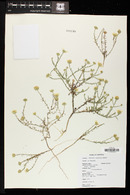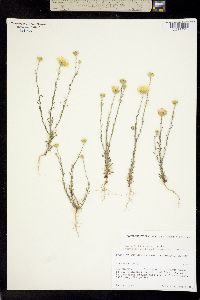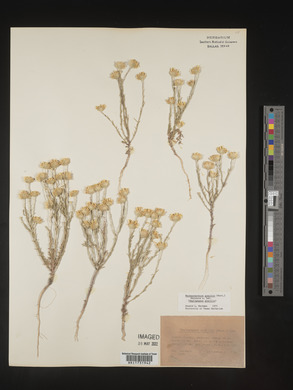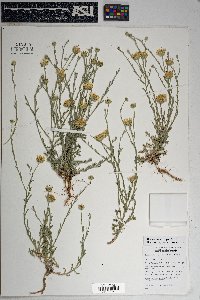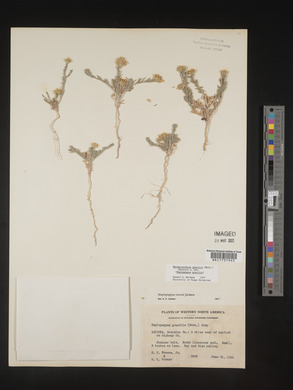
|
|
|
|
Family: Asteraceae
Grass-Leaf Sleepy Daisy, more...slender goldenweed (es: tabacote)
[Dieteria gracilis Nutt., non Aster gracilis Nutt., moreHaplopappus gracilis (Nutt.) A. Gray, Haplopappus ravenii R.C. Jackson, Machaeranthera gracilis (Nutt.) Shinners, Machaeranthera gracilis var. gracilis (Nutt.) Shinners, Sideranthus gracilis (Nutt.) A. Nels., Xanthisma gracilis (Nuttall) D.R. Morgan & R.L. Hartman] |
Annuals, 5-45 cm; taproots 2-5+ cm. Stems 1-15+, often branched at base or throughout, moderately stout to stout, not wiry, moderately hairy (hairs antrorsely appressed). Leaves: basal often withering by flowering, blades 20-60 × 10-25 mm, pinnatifid to 2-pinnatifid; cauline evenly spaced, blades obovate to oblanceolate (proximal), oblong to linear (distal 2 / 3 +), 4-10(-20) × 1-3 mm, markedly reduced distally, margins evenly serrate to serrulate, teeth 3-6 per side, each tipped with prominent white bristle 1.5-2.5 mm, faces moderately hairy (hairs antrorsely appressed). Peduncles moderately hairy (hairs fine, antrorsely appressed, straight to wavy); usually ebracteate. Involucres hemispheric, 0.6-0.8 × 0.8-1.3 cm. Phyllaries in 4-5 series, linear to narrowly spatulate, 2-7 mm, apices usually acuminate, sometimes rounded, tipped by white bristle, faces hairy (moderately antrorsely appressed hairs), sparsely and minutely stipitate-glandular distally. Ray florets 12-26; corollas yellow, tubes 2.2-3 mm, laminae 6-9.5 × 1-2.5 mm. Disc florets 50-100+; corollas 4-5 mm. Cypselae narrowly obovoid to oblanceoloid, 1.5-2.8 mm, nerves 24-28, faces sparsely whitish hairy; pappi whitish to tawny, 4-5 mm, bristles progressively longer adaxially. 2n = 4, 6, 8. Flowering summer-fall. Rocky to sandy washes, plains, slopes, roadsides; 300-2400 m; Ariz., Calif., Colo., Maine, Nev., N.Mex., Tex., Utah; Mexico (Chihuahua). Xanthisma gracile is a species of the Southwest that has been introduced in Maine and possibly other eastern states. Xanthisma gracile is treated here in the broad sense, to include the n = 4 Haplopappus ravenii in addition to the n = 2 and 3 chromosomal races. According to R. C. Jackson (1962, 1971), the n = 4 race can be distinguished from the other two races on the basis of floret and phyllary morphology. The former is said to possess fewer and shorter pappus bristles, shorter cypselae, and phyllaries that are covered by stiffer, more erect hairs. I have been unable to make this distinction with confidence. It is true that H. ravenii (based on specimens from its described geographic range, but not confirmed by chromosome counts) has phyllaries with often sparse, ascending to spreading hairs versus more numerous, longer, and generally appressed. Unfortunately, in surveying several hundred sheets of X. gracile in the broad sense, approximately twenty percent showed intermediacy in this character. Formal recognition of the n = 4 race has been questioned by A. Cronquist (1971) and others.
Wiggins 1964, Kearney and Peebles 1969, Jepson 1993, FNA 2006, Heil et al. 2013, Allred and Ivey 2012 Duration: Annual Nativity: Native Lifeform: Forb/Herb General: Annual herbs, 10-30 cm tall, from a taproot; stems freely branching, bristly. Leaves: Basal leaves early-withering, 2-6 cm long, once or twice pinnately lobed; stem leaves alternate, sessile, and erect (almost appressed to the stem), the blades oblong to linear, 4-20 mm long and 1-3 mm wide, with 3-6 bristle-tipped teeth on each side; leaf surfaces moderately hairy. Flowers: Flower heads showy, yellow, and radiate, at the tips of leafy branches; involucres hemisperic, 6-7 mm high and 7-12 mm wide, the bracts (phyllaries) in 4-6 graduated series, the outer phyllaries much shorter than the inner; phyllaries hairy, straw-colored at the base, grading into a spot of dark green near the tip, and terminating in a bristle; ray flowers 16-18 per flower head, the laminae (ray petals) 7-12 mm long, yellow; disc flowers 44-65 per flower head, yellow. Fruits: Achenes 2-3 mm long, densely long-hairy; topped with a pappus of bristles. Ecology: Found in open, dry sites, including rocky to sandy washes, slopes, and roadsides, from 3,000-7,500 ft (945-2286 m); flowers April-October. Distribution: Southwestern US from CA and NV to CO and TX; south to MEX; also in Maine Notes: Currently classified in Xanthisma, this species has formerly been placed in several other genera including Machaeranthera, Aster, and Happlopappus. Look for a low annual with linear leaves lined with small bristle-tipped teeth, and yellow flower heads at the tips of most branches. Identify it as a member of the Machaeranthera/ Aster group by its flower heads with multiple rows of phyllaries, the outer much shorter than the inner, all with straw colored bases and dark green spots at the tip. However, it is easily distinguished from most members of the Machaeranthera/ Aster group by its yellow ray flowers (blue, purple and white are most common with other members of the group). Appears most similar to Xanthisma spinulosum (formerly Machaeranthera pinnatifida) which also has yellow ray flowers, but that species is a perennial growing from a more or less woody caudex. Ethnobotany: Navajo make a cold tea as a wash for pimples, sores, boils and sore eyes. Steeped tea is used to treat internal injuries and to clear nasal passages. Etymology: Xanthisma is a Greek name meaning that which is dyed yellow; gracilis means graceful or slender. Synonyms: Machaeranthera gracilis, Dieteria gracilis, Haplopappus gracilis, Haplopappus ravenii, Sideranthus gracilis Editor: SBuckley 2010, AHazelton 2017 |
|
|
|

